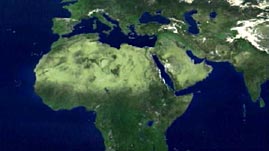Teachers' Domain - Digital Media for the Classroom and Professional Development
User: Preview

Source: Produced for Teachers' Domain
Human activity has reshaped the face of Earth in dramatic, and often unintended, ways. In this visualization adapted from NASA, satellite images show how water diverted from the Aral Sea for agriculture has caused the land-locked lake to shrink considerably over a short period of time. In just 30 years, this lake has lost more than 60 percent of its water. Barring change, the Aral Sea may disappear entirely by 2020.
Just 30 years ago, Asia's Aral Sea was a wide, shallow lake — the fourth-largest inland body of water in the world. Today it is clearly in decline: it has lost nearly two-thirds of its volume of water, shrunk in size by more than half, and had its salinity level triple. Although this lake once contributed about 3 percent of the total fish catch of the former Soviet Union, fishing has ceased completely because freshwater species cannot tolerate the saltier conditions.
What prompted this marked decline? Rivers that fed into the sea were diverted to provide irrigation for cotton croplands. The resulting major reduction of water flowing into the lake caused a significant net loss of water. This in turn led to more water being lost to evaporation than was being replenished, and salinity increased.
The shrinking of the Aral Sea provides a stunning case of desertification as a result of human actions. The humidity of the climate in the region has dropped, and summers are now hotter and winters colder than they used to be. A secondary, and less obvious, effect has followed the rapid exposure of the lakebed. Powerful winds that blow across this part of Asia now pick up and deposit tens of thousands of tons of soil each year. The wind-blown dust has reduced air quality for 5 million nearby residents and, because it has added salt to the soil, contributed to a reduction in crop yield.
Driven by economics, societal need, and personal comfort, humans are reshaping the planet. The vastly changed conditions of the Aral Sea are just one environmental consequence of human mismanagement. Another scene of degradation is in Shenzen China, where ten years of economic growth and commercial development has led to the disappearance of vegetation in the surrounding region. Other problems can be found near dam sites worldwide, where good intentions to control flooding and generate electricity have submerged important wildlife habitats and prevented land-building sediment from flowing downstream.
Many of today's human mismanagement problems occur in developing countries, the areas of greatest population growth. So it bears asking, can better management of natural resources be expected as Earth's population continues to explode? Or will mismanagement ultimately lead to ecological collapse?
Thanks to technological advances, including space-based satellite imaging systems, scientists today can continuously monitor changes to Earth's surface and quickly identify signs of trouble. Their findings, combined with cooperation between government and industry, will be critical to future drought-mitigation programs.
 Loading Standards
Loading Standards Teachers' Domain is proud to be a Pathways portal to the National Science Digital Library.
Teachers' Domain is proud to be a Pathways portal to the National Science Digital Library.
